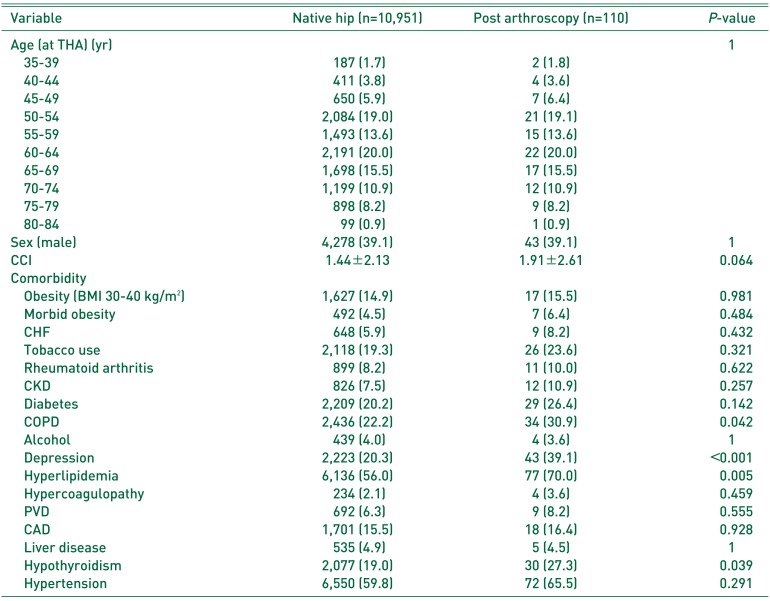1. Ganz R, Parvizi J, Beck M, Leunig M, Nötzli H, Siebenrock KA. Femoroacetabular impingement: a cause for osteoarthritis of the hip. Clin Orthop Relat Res. 2003; (417):112–120.
2. Banerjee P, McLean CR. Femoroacetabular impingement: a review of diagnosis and management. Curr Rev Musculoskelet Med. 2011; 4:23–32. PMID:
21475562.

3. Philippon MJ, Stubbs AJ, Schenker ML, Maxwell RB, Ganz R, Leunig M. Arthroscopic management of femoroacetabular impingement: osteoplasty technique and literature review. Am J Sports Med. 2007; 35:1571–1580. PMID:
17420508.
4. Mehta N, Chamberlin P, Marx RG, et al. Defining the learning curve for hip arthroscopy: a threshold analysis of the volume-outcomes relationship. Am J Sports Med. 2018; 46:1284–1293. PMID:
29337602.

5. Thomas Byrd JW. Hip arthroscopy: surgical indications. Arthroscopy. 2006; 22:1260–1262. PMID:
17165215.
6. Montgomery SR, Ngo SS, Hobson T, et al. Trends and demographics in hip arthroscopy in the United States. Arthroscopy. 2013; 29:661–665. PMID:
23375668.

7. Sing DC, Feeley BT, Tay B, Vail TP, Zhang AL. Age-related trends in hip arthroscopy: a large cross-sectional analysis. Arthroscopy. 2015; 31:2307–2313.e2. PMID:
26194938.

8. Truntzer JN, Shapiro LM, Hoppe DJ, Abrams GD, Safran MR. Hip arthroscopy in the United States: an update following coding changes in 2011. J Hip Preserv Surg. 2017; 4:250–257. PMID:
28948037.

9. Kelly BT, Williams RJ 3rd, Philippon MJ. Hip arthroscopy: current indications, treatment options, and management issues. Am J Sports Med. 2003; 31:1020–1037. PMID:
14623676.

10. Maradit Kremers H, Larson DR, Crowson CS, et al. Prevalence of total hip and knee replacement in the United States. J Bone Joint Surg Am. 2015; 97:1386–1397. PMID:
26333733.

11. Wolford ML, Palso K, Bercovitz A. Hospitalization for total hip replacement among inpatients aged 45 and over: United States, 2000–2010 [Internet]. Hyattsville: Centers for Disease Control and Prevention;2015. 2. cited 2019 Jan 15. Available from:
https://www.cdc.gov/nchs/data/databriefs/db186.pdf.
12. Kurtz SM, Lau E, Ong K, Zhao K, Kelly M, Bozic KJ. Future young patient demand for primary and revision joint replacement: national projections from 2010 to 2030. Clin Orthop Relat Res. 2009; 467:2606–2612. PMID:
19360453.

13. Werner BC, Burrus MT, Novicoff WM, Browne JA. Total knee arthroplasty within six months after knee arthroscopy is associated with increased postoperative complications. J Arthroplasty. 2015; 30:1313–1316. PMID:
25791670.

14. Piedade SR, Pinaroli A, Servien E, Neyret P. Is previous knee arthroscopy related to worse results in primary total knee arthroplasty? Knee Surg Sports Traumatol Arthrosc. 2009; 17:328–333. PMID:
19099293.

15. Charles R, LaTulip S, Goulet JA, Pour AE. Previous arthroscopic repair of femoro-acetabular impingement does not affect outcomes of total hip arthroplasty. Int Orthop. 2017; 41:1125–1129. PMID:
27785537.

16. Haughom BD, Plummer DR, Hellman MD, Nho SJ, Rosenberg AG, Della Valle CJ. Does hip arthroscopy affect the outcomes of a subsequent total hip arthroplasty? J Arthroplasty. 2016; 31:1516–1518. PMID:
26860964.

17. Perets I, Mansor Y, Mu BH, Walsh JP, Ortiz-Declet V, Domb BG. Prior arthroscopy leads to inferior outcomes in total hip arthroplasty: a match-controlled study. J Arthroplasty. 2017; 32:3665–3668. PMID:
28735801.

18. Spencer-Gardner LS, Camp CL, Martin JR, Sierra RJ, Trousdale RT, Krych AJ. Does prior surgery for femoroacetabular impingement compromise hip arthroplasty outcomes? J Arthroplasty. 2016; 31:1899–1903. PMID:
27026643.

19. Zingg PO, Schallberger A, Rüdiger HA, Poutawera V, Dora C. Does previous hip arthroscopy negatively influence the short term clinical result of total hip replacement? Arch Orthop Trauma Surg. 2012; 132:299–303. PMID:
21800199.

20. Leunig M, Beaulé PE, Ganz R. The concept of femoroacetabular impingement: current status and future perspectives. Clin Orthop Relat Res. 2009; 467:616–622. PMID:
19082681.

21. Bedi A, Chen N, Robertson W, Kelly BT. The management of labral tears and femoroacetabular impingement of the hip in the young, active patient. Arthroscopy. 2008; 24:1135–1145. PMID:
19028166.

22. Thomas Byrd JW. Hip arthroscopy in athletes. Oper Tech Sports Med. 2005; 13:24–36.

23. McCarthy JC, Lee JA. History of hip arthroscopy: challenges and opportunities. Clin Sports Med. 2011; 30:217–224. PMID:
21419953.

24. McCarthy JC, Lee JA. Hip arthroscopy: indications, outcomes, and complications. Instr Course Lect. 2006; 55:301–308. PMID:
16958465.
25. Sampson TG. Complications of hip arthroscopy. Tech Orthop. 2005; 20:63–66.

26. Nakano N, Khanduja V. Complications in hip arthroscopy. Muscles Ligaments Tendons J. 2016; 6:402–409. PMID:
28066747.

27. Kowalczuk M, Bhandari M, Farrokhyar F, et al. Complications following hip arthroscopy: a systematic review and metaanalysis. Knee Surg Sports Traumatol Arthrosc. 2013; 21:1669–1675. PMID:
22940810.

28. Chaudhry ZS, Salem HS, Hammoud S, Salvo JP. Does prior hip arthroscopy affect outcomes of subsequent hip arthroplasty? A systematic review. Arthroscopy. 2019; 35:631–643. PMID:
30612772.

29. Papavasiliou AV, Bardakos NV. Complications of arthroscopic surgery of the hip. Bone Joint Res. 2012; 1:131–144. PMID:
23610683.

30. Bedi A, Galano G, Walsh C, Kelly BT. Capsular management during hip arthroscopy: from femoroacetabular impingement to instability. Arthroscopy. 2011; 27:1720–1731. PMID:
22047925.

31. Abbas K, Murtaza G, Umer M, Rashid H, Qadir I. Complications of total hip replacement. J Coll Physicians Surg Pak. 2012; 22:575–578. PMID:
22980611.
32. Parker SJM, Grammatopoulos G, Davies OLI, Lynch K, Pollard TCB, Andrade AJ. Outcomes of hip arthroplasty after failed hip arthroscopy: a case-control study. J Arthroplasty. 2017; 32:3082–3087.e2. PMID:
28602531.








 PDF
PDF ePub
ePub Citation
Citation Print
Print




 XML Download
XML Download